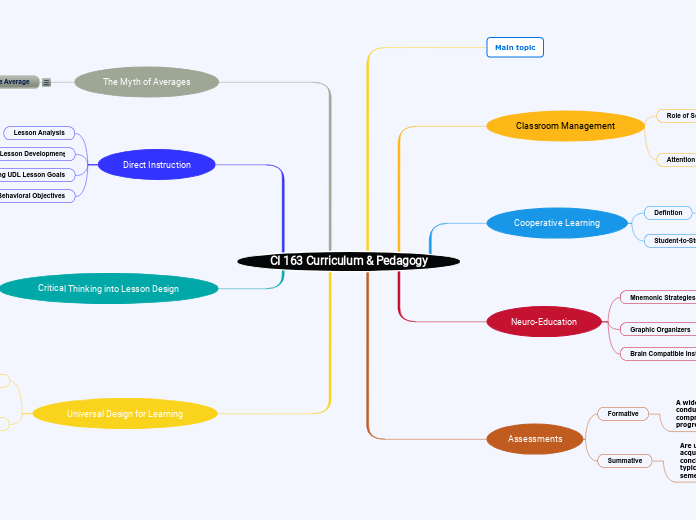CI 163 Curriculum & Pedagogy
Main topic
Classroom Management
Role of Socio Emotional Learning
Show Interest in Student's Work
Invite student to ask for help
Make Time for Conversations
Attention Continuum and Surface Management
Cooperative Learning
Defintion
The process of breaking a classroom of students into small groups so they can discover a new concept together and help each other learn
Student-to-Student Structure
Neuro-Education
Mnemonic Strategies
Designed to help students improve their memory of important information. This technique connects new learning to prior knowledge through the use of visual and/or acoustic cues
Graphic Organizers
Brain Compatible Instructional Strategies
Active learning
Assessments
Formative
A wide variety of methods that teachers use to conduct in-process evaluations of student comprehension, learning needs, and academic progress throughout the instructional year.
Summative
Are used to evaluate student learning, skill acquisition, and academic achievement at the conclusion of a defined instructional period—typically at the end of a project, unit, course, semester, program, or school year.
The Myth of Averages
Ban the Average
Rather than design to the average, we must design to the edges and this will allow us the ability to reach those students who would've been out of arms length.
Direct Instruction
Lesson Analysis
Lesson Development
Designing UDL Lesson Goals
Writing Behavioral Objectives
Critical Thinking into Lesson Design
Bloom's Taxonomy
a set of three hierarchical models used to classify educational learning objectives into levels of complexity and specificity. The three lists cover the learning objectives in cognitive, affective and sensory domains
Z Charts for Writing Objectives
Depth of Knowledge
designates how deeply students must know, understand, and be aware of what they are learning in order to attain and explain answers, outcomes, results, and solutions
Universal Design for Learning
Barriers to Traditional Education
UDL Principles
Representation
Engagement
Action & Expression
